
What is PIM (Product Information Management) and How to Do It with Pimcore?
Recent years have proved that the Internet has become the most important sales channel for business. And although we are actually a few clicks away from the customer, and we’re able to open our first online store in just a few moments, it’s easy to get lost among the numerous possibilities. Product Information Management will help you avoid such a situation. Find out what PIM is, how it facilitates working across multiple sales channels, and how the Pimcore system – which may be the right solution for you – works in all this.
What is PIM?
Product Information Management (PIM) is the process of managing product information across all of the company’s sales channels. PIM tools and systems enable collecting, storing, sharing and updating data from various sources in one central spot.
Enterprises more and more often use PIM to improve and facilitate the information flow about the offer, and thus – to maintain the consistency of the message across their channels, which translates into caring for a better customer experience.
Product information from PIM system can be used for various distribution channels. Here are some examples:
- Online stores: product information from PIM can be automatically sent to online shops to update product descriptions, prices, and availability.
- Catalogues: companies can utilize the product information from PIM tools to create product catalogues that are shared with customers or business partners.
- Ecommerce platforms: PIM solution can be used to manage information about products on various ecommerce platforms such as Shopify and Magento, as well as on marketplaces (e.g., Amazon, Etsy or Alibaba).
- Social media: PIM may come in handy for creating social media content, such as Facebook or Instagram posts that promote products.
- Advertisements: the product information from PIM system can be operated to create advertisements presenting products and their features.
PIM enables the automation and improvement of the processes related to the distribution of product information, which increases the effectiveness of marketing and sales activities.
What is PIM software?
What exactly is the PIM software for businesses then? It's a system that meets the above-mentioned goals and allows user to centralize product information, manage it and distribute it across all possible channels.
There are many different Product Information Management solutions available on the market – both free and paid versions, with various functions and levels of complexity.
Here are some examples of popular PIM systems:
- Pimcore,
- Akeneo,
- Agility Multichannel,
- Syndigo,
- Inriver,
- Catsy,
- Plytix,
- Informatica.
In addition to general goals and functionalities, all these systems operate in their unique way. In this article, we’d like to introduce you to Pimcore and - most of all - point out what sets it apart from the competition and why it's worth taking an interest in this particular software.
Pimcore – open source software
Pimcore is an open source tool which we can use without any restrictions, by modifying it to meet our own needs. This provides extraordinary flexibility and scalability. Under the hood of Pimcore stands the popular and still developing PHP Symfony framework. Thanks to this we don't have to worry about the technological aspect of the system, and what’s more – the countless online studies and tutorials make it much easier to work with the tool.
However, the unique features of this platform don’t end there – this software also stands out due to its versatility. In addition to product information storage, we also get a comprehensive, yet easy-to-use asset and document management system. In turn, the ecommerce elements and the CMS nature of this software mean that after adding them, the Pimcore installation can become an online store.
Product Information Management with Pimcore
Pimcore is full of features that are perfect for improving our organization. In addition, its open source nature makes it one of the most flexible solutions of this type – open to modifications and often supplemented with new functionalities.
What information about products can we manage in the system? All kinds of data, actually – from basic descriptions and product codes (e.g. EAN), photos (with a built-in editor), to more complex ones, such as product variations or geolocation. The possibilities are really great here, and Pimcore provides us with fully configurable fields out-of-the-box that we can use to describe our product (we can find the complete list in the Pimcore documentation).
In this article, we'll show you a few examples of Pimcore functionalities that make the work easier and perfectly highlight the advantages of using the centralized Product Information Management provided by this PIM system.
1. Data modelling
Data modelling is the basic functionality of Pimcore and its strength. Thanks to it, we’re able to create both simple and complex data models of an unlimited amount and type. We have over 40 types built into the system at our disposal, as well as the ability to create our own ones.
A few types of data models worth checking out include:
- Country: contains a predefined list of countries,
- Geopoint: a map widget allowing us to find longitude and latitude,
- Image/Video: a field for a photo or video with a preview,
- Calculatedvalue: a field that allows us to calculate values (e.g., kilograms to grams) on the fly using additional PHP code.
Pimcore was designed to processing millions of products, which makes the tool both efficient and easy to use (modelling is done from the administrator panel and consists in adding new fields to a previously prepared model).
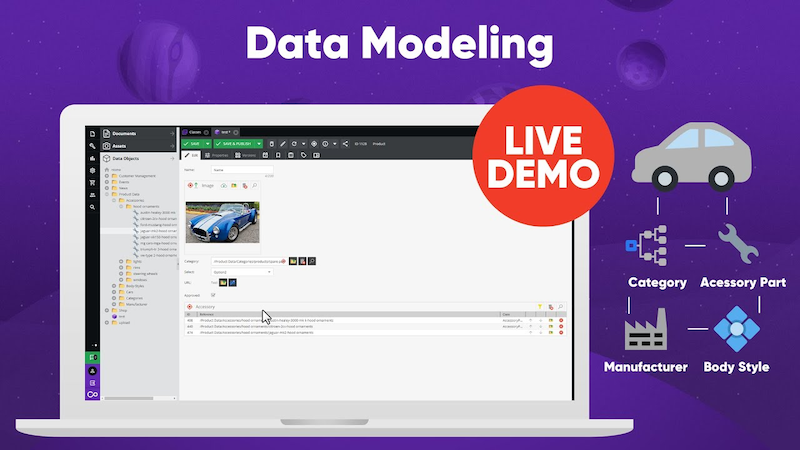
Source: Pimcore
With multilingual support (we can add any language at any time) and the ability to create simple and complex products (e.g., containing various relations and a multi-level structure), we get an extremely versatile and comprehensive solution which responds even to the most complex needs.
2. Importing and exporting data
Pimcore's built-in content importing and exporting system will help us with field mapping using a simple interface. The function enables importing from the most popular format used in most systems: CSV.
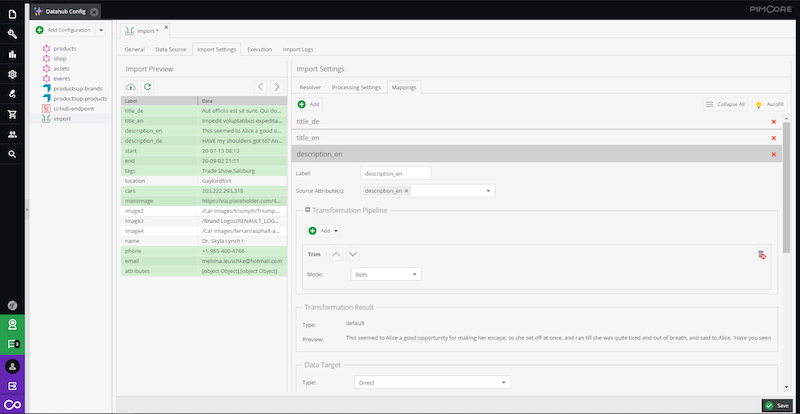
Source: Pimcore
However, if this simple solution isn't enough, we can use the free Data Importer extension, which will expand the tool, adapting it to more demanding situations.
In this case, we have practical options at our disposal, such as:
- a higher number of supported formats, including: CSV, XLSX, JSON, XML,
- an ability to remotely transfer files using an HTTP or SFTP connection.
3. Multi-system integrations
In addition to the mentioned data importing, Pimcore has an extensive API that can be used to integrate with virtually any other system (including ERP, CRM, BI, ESB). It’s worth noting that this method of communication was the basis of the software itself, which in principle (apart from the CMS aspects) is a headless tool, i.e., separating the logic from the graphical user interface.
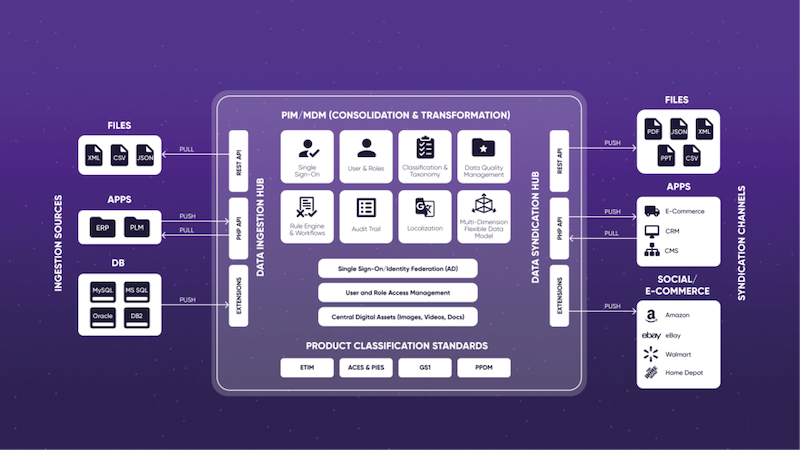
Source: Pimcore
An essential example of integrations available directly in the Pimcore system is the option to connect with Microsoft Excel. Thanks to this, all data models can be freely exported and imported to the CSV format, which is easy to read by spreadsheets (Microsoft Excel, Google Sheets).
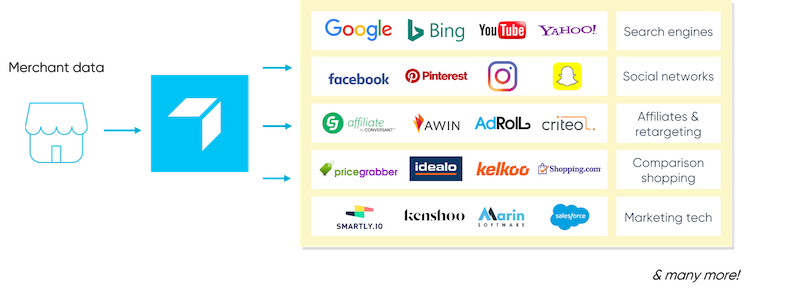
The paid version (Cloud or Enterprise) also offers ready-made integrations with over 2,500 sales channels. Through them, we can quickly and easily connect our Pimcore with popular services such as Google, Amazon, Facebook, Instagram, etc.
4. Product life cycle management
Using Pimcore, we can also modify and create life cycles for every product, modelling them freely and easily. Individual statuses of products can also affect their display and be associated with specific actions that are about to happen. If we add to this the option to set notifications about any changes, we'll get a comprehensive solution for ecommerce, allowing us to organize even the most complex processes.
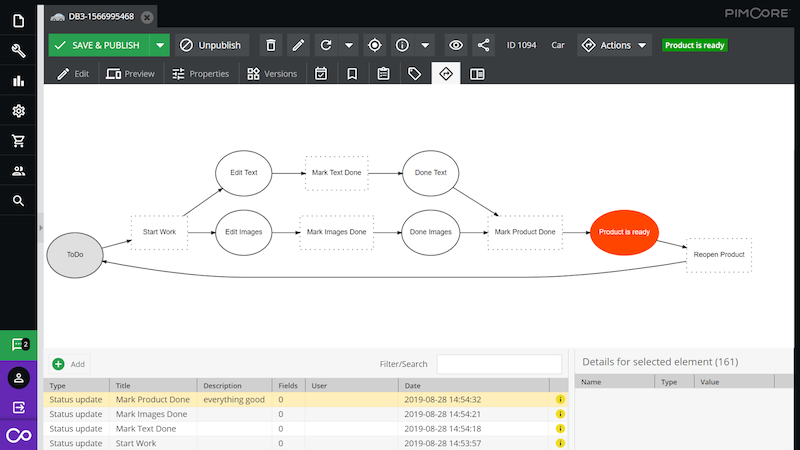
Source: Pimcore
5. Photo and video conversion
An essential element of the presentation of every product, apart from its description on the product page, is a photo or video. Pimcore is able to handle many photo and video formats, and more importantly – their conversion and modification. Thanks to this, we can carry out – for example – a simple change of dimensions or compression process, as well as perform more complex tasks, such as cropping or preparing many variants tailored to display on the screens of specific devices.
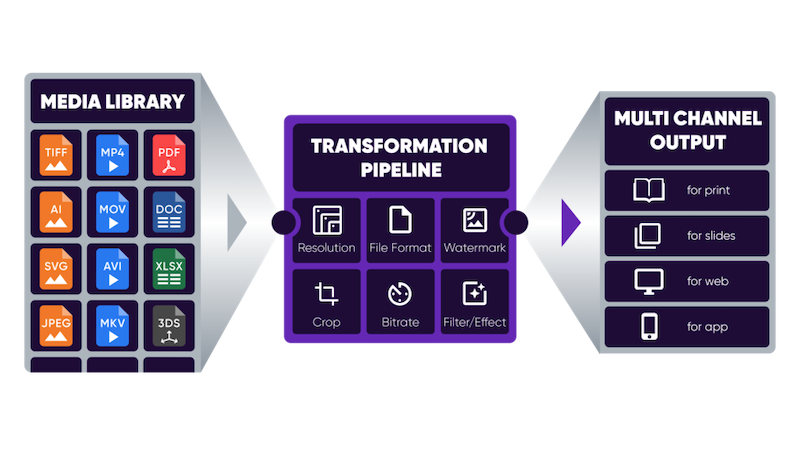
Source: Pimcore
6. Versioning
Another important functionality of this system also deserves our attention. Both the assets, and data available in Pimcore are versioned, which means that every change introduced to them is recorded in the system along with the author and modification date. What's more, Pimcore also enables restoring and publishing earlier versions, ensuring a lot of security when working with our products.
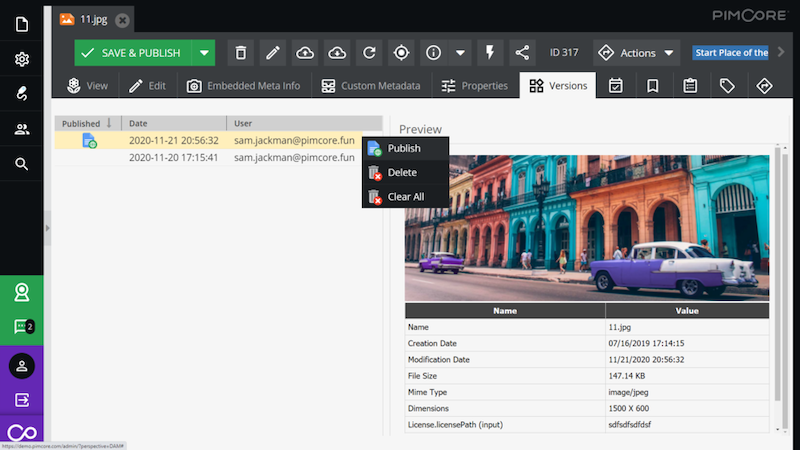
Source: Pimcore
What is PIM – summary
PIM solution is a very comprehensive and exciting subject. The examples presented in this article are only a fraction of all the possibilities offered by such systems. If your business relies on multiple sales or advertising channels, it's worth considering centralized product information management in one place. This approach not only greatly helps in everyday work, but also enables expanding current activity and opening up to new development directions, for which, e.g., there wouldn’t be enough time under normal circumstances.
Using the Pimcore system allows you to increase the level of provided services quality, unify and simplify the distribution of products, and as a result – contribute to improving customer experience. We help, for example, with the development and maintenance of this type of software to make it easier for companies to achieve their intended results. Sounds good? Check out our Pimcore Development services.











